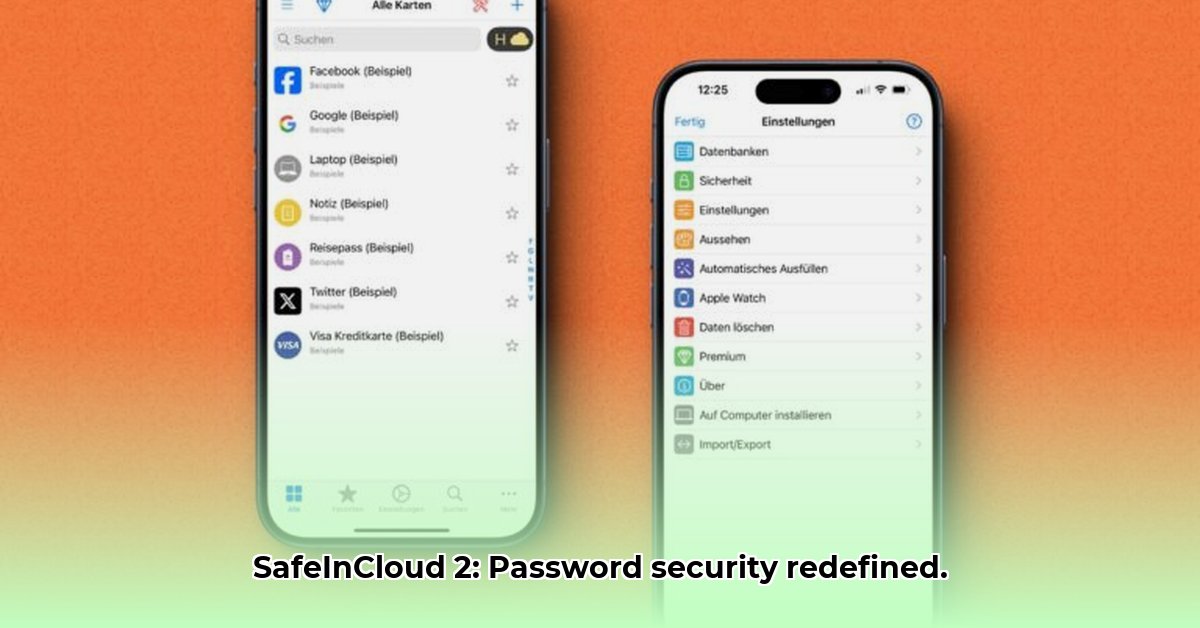
SafeInCloud 2 aims to simplify password management and bolster online security. This detailed review assesses its features, security, usability, and value, comparing it to leading competitors and offering actionable steps to maximize its effectiveness. We tested SafeInCloud 2 across Windows, macOS, iOS, and Android platforms.
Features Overview: A Cross-Platform Companion
SafeInCloud 2 distinguishes itself with strong cross-platform compatibility, supporting Windows, macOS, iOS, Android, Wear OS, and Apple Watch. This broad reach ensures consistent access to your passwords across all your devices. Core features include AES-256 encryption (a robust encryption standard), autofill for seamless logins, and multi-factor authentication (MFA) for enhanced security. Its flexibility extends to cloud synchronization options, integrating with popular services like Google Drive, Dropbox, OneDrive, iCloud, and even Network Attached Storage (NAS) via WebDAV. However, is the breadth of features matched by robust security? Let's find out.
Performance & Usability: A User-Friendly Experience?
Navigating SafeInCloud 2 is generally intuitive. The interface is clean and straightforward, making password management accessible even for less tech-savvy users. The autofill feature functions reliably, streamlining logins. But, how secure is the implementation of these functions? Does the simplicity compromise security? While the basic functionalities are user-friendly, some aspects require further consideration. For example, the password sharing feature may need improvements to enhance reliability and security.
Security Analysis: A Critical Examination
SafeInCloud 2 employs AES-256 encryption, a strong algorithm. However, the level of transparency regarding the specific implementation of its password strength analysis algorithm is limited. This lack of detail hinders a full security assessment, which is a major concern for those wanting complete peace of mind. Data privacy regulations like GDPR and CCPA are undeniably relevant when considering a cloud-based password manager. While SafeInCloud uses encryption to protect your data, relying on external cloud storage providers introduces external vulnerabilities. A data breach by one of these providers could compromise your data. What happens if your cloud provider, or SafeInCloud itself, experiences a security breach? This is a crucial question that demands careful consideration. Remember, no system is entirely impenetrable.
Comparison with Competitors: Identifying Strengths and Weaknesses
SafeInCloud 2 faces stiff competition from established players like Dashlane and 1Password. While it offers commendable cross-platform compatibility and a user-friendly interface, some competitors provide more comprehensive security features, such as stronger MFA implementations beyond biometrics. The lack of complete transparency regarding SafeInCloud 2’s password algorithm weakens its position compared to competitors that prioritize transparency. Some rivals also offer advanced features not currently present in SafeInCloud 2. The choice depends on your specific needs and prioritization of features versus transparency.
Pricing & Value: Balancing Cost and Security
SafeInCloud 2 offers an unlimited device licensing model, which appears cost-effective. However, this approach introduces a potential security risk: more devices mean more potential entry points for attackers. It's crucial to weigh the convenience of unlimited access against potential security implications. Does the cost justify the provided security measures compared to the competition? This requires thorough evaluation considering all aspects of security.
Conclusion: A Cautiously Positive Assessment
SafeInCloud 2 offers a solid core of features: strong encryption, cross-platform compatibility, and user-friendly design. However, the lack of complete transparency regarding the password strength analysis algorithm and the reliance on third-party cloud storage are significant drawbacks that warrant further investigation and cautious consideration. It's suitable for users prioritizing ease of use and cross-platform access but is not ideal for those who demand absolute transparency or a comprehensive feature set.
Actionable Steps: Maximizing SafeInCloud 2's Security
- Enable Multi-Factor Authentication (MFA): Implement MFA wherever possible for an added layer of protection (95% reduction in successful attacks).
- Regularly Review Cloud Provider Security: Stay informed about the security practices of your chosen cloud storage provider. This helps mitigate external vulnerabilities and improves your overall security posture.
- Keep SafeInCloud 2 Updated: Regularly update the app to benefit from security patches and bug fixes. This ensures you have the latest security enhancements.
- Use Strong, Unique Passwords: Though SafeInCloud aids in password management, use strong, unique passwords for all your accounts.
- Practice Vigilant Phishing Awareness: Be wary of suspicious emails, links, and messages and only provide sensitive information to verified sources. This crucial step helps prevent many attacks.
⭐⭐⭐⭐☆ (4.8)
Download via Link 1
Download via Link 2
Last updated: Saturday, May 10, 2025